This is a guest blog post by Ryan Carey, of My 3 Quotes.
How important is a well-known name brand for you? That is a big question, and the answer greatly affects our buying decisions. For example, when several in-home window presentations by high-pressure salespeople are giving you a headache, do you get generic ibuprofen, or do you pay a little extra for Advil? The generic brand shows the same percentage of ingredients, but this is a huge headache, so maybe it’s best to be on the safe side?
Over the years, the most common question I get is, “So how does this window compare against Andersen, Marvin, or Pella?” I could show the comparable ingredients or the same U-factors, but some folks are just more comfortable with that well-known name brand. They know the manufacturer has been around for a long time and therefore has made many customers happy. They are also concerned about the company being around in the future for warranty issues.
If you read Window Replacement: Part 1, you know how important I believe U-factors are in new windows. In Part 2, I reviewed the pros and cons of different window materials and installation methods. For Part 3, we will focus on the Big 3: Marvin, Andersen, and Pella. You won’t normally hear unbiased opinions on these windows because, typically, the person doing the writing has a particular window they are trying to sell.
Straight Talk
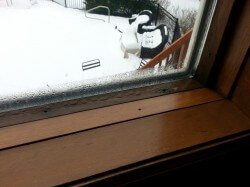
To begin, I want to say every one of these companies’ windows dealt with problems in the ’70s, ’80s, and even into the ’90s before Low E, Argon-filled glass came along. This had not as much to do with them as it did with the struggle of finding a wood interior window that worked with the new technology of double pane glass and aluminum spacers. EVERY company had issues with that. Hardwood was no longer being used for windows; it was mostly soft, quick-growth pine. The two clear glass panes were separated by an aluminum spacer on the perimeter, which transferred in the cold from the outside because the aluminum is very conductive. That area would develop condensation, freeze, thaw, and destroy the wood where it meets the glass. Sometimes the water got into the frame and completely rotted it out.
I kept running into the same thing with homeowners. If their windows from that era were Marvin, they hated Marvin and would never use them again. If they had Andersen, they hated Andersen and would never use them again. If they had Pella, well, you can guess. This is why you will find many negative reviews about every kind of window out there. Unless the homeowner had very good humidity control, the customer was in for trouble with wood windows from that era in our state. Many negative reviews were also the result of bad installs.
Times have changed; spacers have changed to less conductive stainless steel, U-shaped tin steel, and foam polymers (my personal favorite-virtually no conduction of cold). Low-E and Argon glass has also hindered temperature transfer and greatly cut down UV rays that help damage the wood. While the performances have greatly improved and the wood will last longer, I still prefer not to put a real wood window with any type of metal spacer in my house. Even if it is just a little maintenance from time to time with some steel wool and varnish, it is more than I want to do. Many people love real wood and feel differently than me on that topic.
Times have also changed with the window market. Back in the day, these big window brands were mainly new construction, and none of them used to offer custom sizes for remodel openings. Times were so good they would actually tell customers, “YOU alter YOUR openings to fit OUR windows.” Needless to say, they have all jumped headlong into the custom-sized replacement window market at this point.
MARVIN:
It shouldn’t be a surprise that Marvin and Andersen are the most asked-for windows from local customers, considering they reside here in Minnesota.
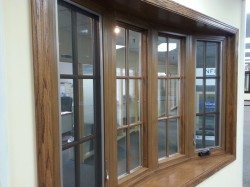
Marvin has been making windows since the ’20s, and they have changed along with the times. Their Signature wood window is clad with aluminum on the exterior. They have also gone to fiberglass on the exterior with their Elevate line (real wood interior) and Essential (all fiberglass). They also make Infinity, their lifetime all-fiberglass line that has an option for a stainable interior (not real wood). Marvin is the one company out of all mentioned that have completely refused to use vinyl in any window line, so they pitch strongly against it. Their Signature line (aluminum-clad with wood interior) is a beautiful window with a high price, and it has more options than you can shake a stick at (if you’re in a stick-shaking mood).
I’m a big fan of Marvin; I believe in the craftsmanship of their entire product line. If I had to choose one of their windows, I would go for the lifetime warranty Infinity. Fiberglass is as good as it gets; couple it with their Everwood interior for the look and stainability of wood without actually having to worry about wood decay, and you have me sold. It is also on the high end of pricing, though not as expensive as their Signature aluminum-clad wood line.
ANDERSEN:
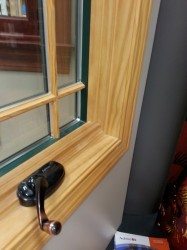
Andersen is the only company of the Big 3 that uses wood wrapped in vinyl on the exterior. The wood strengthens the vinyl, leaving an exterior that is low maintenance yet rigid. Andersen’s top line, the 400 series, is high-end priced as well. I would take a Marvin over Andersen in the double-hung department (I like the traditional look), but I would take the Andersen casement over a real-wood Marvin. They wrap the entire sash (the part that cranks out) in vinyl, so there is no trouble spot of wood against glass. You do see the outline of vinyl on the interior, but the profile is narrow enough that most people don’t mind. It’s well worth it to avoid the potential wood decay. Andersen also makes an all-vinyl wrapped patio door in their PermaShield line if you want to avoid exposed wood on the interior.
So what about Andersen Renewal? Talk about a company that advertises everywhere! Renewal by Andersen is its own company, separate but obviously owned by the main company, and also high-priced. Renewal products are made from a composite material called Fibrex, which is part wood and part vinyl. This is very smart by Andersen, as they use up all of the by-products of their other lines (which are made of wood and vinyl separately). Renewal products are not available to contractors like their other lines; you must purchase the installation straight from Renewal. They feature a more rounded, contemporary look, and customers I’ve run across have been very positive about the product in their homes. They offer stainable interiors or low-maintenance Fibrex interiors. However, their stainable interior is a real-wood veneer, so it can deteriorate and get mold spots just like real wood. This is where Marvin Infinity has the advantage of a non-organic stainable interior that won’t deteriorate from moisture. If you’re going with a solid Andersen Fibrex color, you won’t have to worry about that potential deterioration or mold.
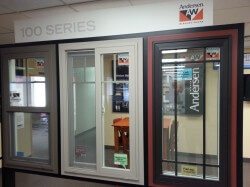
Andersen 100 series is a very intriguing window line. Some call it “Renewal Lite” since it is also made of Fibrex. They only have solid-color interiors, which takes some people out of the mix if they want a wood look. However, if a solid color on the inside is OK by you, this is the best opportunity to get a big-name window at a lower price. I like their sliders and casements. The one caveat is their single-hung; that thing is a nightmare if you want to pop out the sash and clean it from the inside. Since the top sash is stationary, it is called a single hung (not a double hung). That’s not the problem. The problem is it doesn’t have the typical tilt-in feature for cleaning; it has a metal peg that you flip out before lifting the sash up. When the sash goes up, the peg should push the sash out of the frame for cleaning, but many times the peg flies out instead. If you don’t need to clean from the inside, then don’t worry about it. If you do, stick with the sliders and casements, and you’ll get a good value.
Andersen also makes an aluminum-clad wood window in the E-series and a Fibrex clad wood window in the A-series. If there is a particular window style you want and you want to use Andersen, chances are you will find what you like with all the choices they have.
PELLA:
Well, Pella certainly took a “we’re not fooling around” approach to jumping into the remodel market. They make three series of wood windows with aluminum cladding, a fiberglass line, and a vinyl line as well! On the vinyl side, their 250 series can be compared to many other vinyl windows with the bonus that they carry the Pella name. They also make an all-fiberglass window in Impervia, with solid-color interiors available.
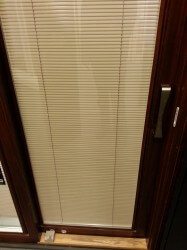
Pella makes a finely detailed wood line called the Reserve Series in both a Traditional and Contemporary version, which is a well-crafted window with a higher price tag. Their Lifestyle Series is option-friendly and one of the only lines that has really perfected the “blinds between the glass panes” option. If you want blinds in your glass instead of on the inside of your home, this is the best line for you. Pella treats their wood with a special process, and now they offer a lifetime warranty on their wood windows. That is very rare, so if you insist on all real wood on the inside, it can be a great option for you.
I also have to bring up Pella’s patio door lines. They are well-made, but they are the only company I’ve ever seen that puts the patio screen on the inside, not the outside. They say this protects the abuse of an exterior track, and they put a nice wood finish on the screen, but it is impractical for its main use- keeping bugs out. Imagine a summer night with 200 mosquitoes on your screen, thirsting for your blood like a pack of zombies. When it’s time for bed, you have to open the screen to close the outside panel of the patio door, then quickly close the screen again so they don’t all get in. Now they are all trapped between the two panels. I’m not a fan of that design for states with bug-heavy summers.
So, that is my opinion on some of the pros and cons of the Big 3. I hope you find it helpful. If you want more detail or have more questions on any exterior product, I am available by phone or e-mail. Contact information is on our website below.
Window Replacement Blogs
Here are the other blogs in this series:
 Ryan Carey has over 20 years of experience in exterior remodeling for Twin Cities Homeowners and Property Management Companies. He is the owner of “My 3 Quotes,” a company that provides the free service of collecting 3 competitive home improvement bids for customers. For more information, visit www.getmy3quotes.com for free home improvement estimates on window replacement and more.
Ryan Carey has over 20 years of experience in exterior remodeling for Twin Cities Homeowners and Property Management Companies. He is the owner of “My 3 Quotes,” a company that provides the free service of collecting 3 competitive home improvement bids for customers. For more information, visit www.getmy3quotes.com for free home improvement estimates on window replacement and more.
